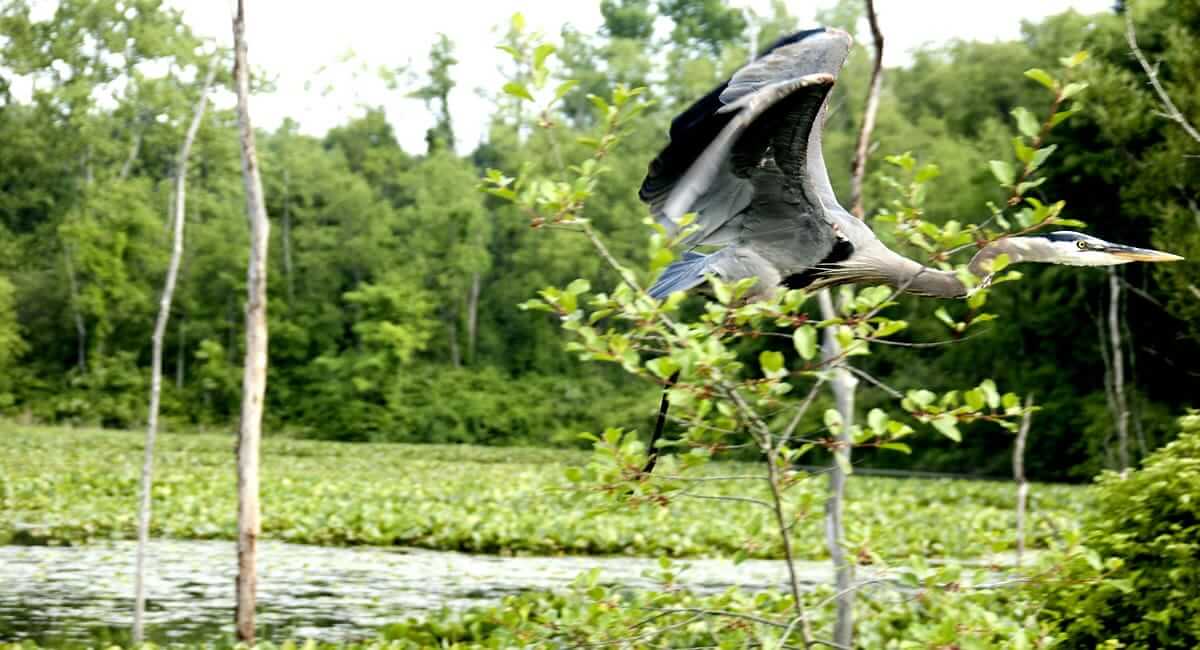The Great Blue Heron is one of the most majestic birds in our area. Our local Cuyahoga Valley National Park, which is 33,000 acres in total, is a favorite habitat for these fascinating animals.
 Blue Heron in flight at CVNP Beaver Marsh (photo credit: Brad Shorb)
Blue Heron in flight at CVNP Beaver Marsh (photo credit: Brad Shorb)
Where Can I Find Great Blue Herons?
Keep an eye out while hiking CVNP as you might find one of the local heronries listed below. Read further for more interesting facts to keep in mind as you search for the Great Blues in our area.
- Bath Road - highly visible 110 nest heronry between Akron-Peninsula and Riverview road (81° 34.282' W) (41° 9.783' N)
- Bath Road North - 24 nests along both banks of the Cuyahoga River north of Bath Road
- Pinery Narrows - 100 nest heronry along the Cuyahoga River north of Station Road Bridge Trailhead in Brecksville; new nests are high on the valley rim, tucked away and hard to see
- Wetmore Road - small tucked away heronry that has been in use since 2006
 Blue Heron standing in midst of CVNP Beaver Marsh (photo credit: Brad Shorb)
Blue Heron standing in midst of CVNP Beaver Marsh (photo credit: Brad Shorb)
What Do Great Blue Herons Look Like?
Great Blue Herons can be 3-5 feet tall, can have a 5-7 foot wingspan, and can fly 30 miles per hour. Despite their impressive stature, they only weigh 5-6 pounds because of their hollow bones, a feature they share with other birds. Their feathers are blue-grey. A black stripe masks their eyes like a bandit.
When you’re visiting Cuyahoga Valley National Park, you can see Great Blue Herons standing still in water or slowly walking as they hunt for food. In flight, you can easily recognize their figures; they have a broad wingspan, their long legs stretch straight behind them, and their necks curve like an S (specially designed vertebrae in their necks make this S-curve possible).
What Do Great Blue Herons Eat?
Great Blue Herons eat small fish, insects, mice, frogs, turtles, snakes, or other small creatures. Usually they are found in saltwater or freshwater, but occasionally you can find them in fields. Their typical habitats are the United States, Canada, or Alaskan coasts.
Where Do Great Blue Herons Nest?
In early spring, the normally solitary herons gather to breed in colonies called heronries, where they build their nests in tall trees. The coupled herons take anywhere between three days and two weeks to build their nests, which average four feet wide and three feet deep. The female lays 2-7 eggs. The couple cares for the eggs for twenty-eight days. Just two months after they hatch, the young herons can survive alone.
 Closeup of Great Blue Heron at CVNP Beaver Marsh (photo credit: Brad Shorb)
Closeup of Great Blue Heron at CVNP Beaver Marsh (photo credit: Brad Shorb)
Hiking & Great Blue Herons
At Appalachian Outfitters and Kendall Cliffs, we regularly schedule hikes into Cuyahoga Valley National Park, and sometimes we see Great Blue Herons.
Join us for one of our hikes to learn more about the Great Blue Heron!

